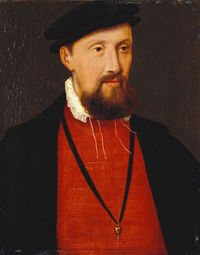Clan Douglas and The Battle of Ancrum Moor

Archibald Douglas
In 1545 the aptly titled War of Rough Wooing was in full, ruthless swing. In order to gain Scotland’s allegiance to England, King Henry VIII employed the curious tactic of scorching and pillaging Scotland into submission. In retaliation, approximately 2,500 Scottish soldiers were raised by the Chief of Clan Douglas, Archibald Douglas 6th Earl of Angus, with help from James Hamilton, 2nd Earl of Arran. They gathered just a few miles from the Scottish border town of Jedburgh, confronting 5,200 English soldiers on 27 February 1545 at the Battle of Ancrum Moor.
Towards the end of Henry VIII’s reign, the King sought to unify the Kingdoms of England and Scotland through the arranged marriage of his son Edward, and Mary, Queen of Scots (aged one at the time). After much discussion and dissension, the Scottish Parliament under the Earl of Arran (Queen Mary’s regent) rejected Henry’s proposal, and instead offered the infant’s hand to the French, thus renewing the ‘Auld Alliance’.
Henry reacted rather badly to the news, and declared war against Scotland. Major hostilities broke out in Edinburgh in 1544, where Henry ordered the Earl of Hertford to burn Edinburgh, Leith and much of the border towns to the ground. The burning and pillaging of the borders continued into 1545, led by Sir Ralph Eure. Douglas’s estate had suffered heavily during the attacks – his family tombs at Melrose Abbey were vandalised by Eure, and Henry VIII had even given Eure some of Douglas’s land in the borders. The attacks forged an unlikely alliance between Douglas and Arran who had been bitter rivals for many years, even fighting a pitched battle in the streets of Edinburgh in 1520. Douglas was also joined at the battlefield by Scott of Buccleuch, whose lands had also been destroyed in the attacks.
The English command numbered approximately 5,200 and was made up of 3000 German and Spanish mercenaries, 1,500 English borderers and 700 disaffected Scots. As they settled into their encampment under Gersit Law, a small Scottish force made an attack then retreated. The English gave chase over the hill, where they met the entirety of the Scots force made up of predominantly Douglas men. Gleefully hidden on the far side of the hill, the Scots, although largely outnumbered, had the advantage of surprise and of the setting sun which was behind them. The English front line cracked under the might of the Scots pikemen, never being able to secure enough solid ground on the hill to launch a substantial attack. This sent the army into disarray, scattering the troops into the hostile countryside.
The English lost 800 men, including Eure, to the Scots two casualties. 1000 English men were also taken prisoner. Scotland’s incredibly decisive victory was enough to cool Henry VIII’s wrath for the meantime, however the war waged on until shortly after the death of the King in 1547. Local lore also says that a Lady Lilliard took part in the battle to avenge the death of her lover who was killed by English troops. Lilliard fought until dying of her wounds on the battle field, where an inscribed stone now lies in memory of her.
Fair maiden Lilliard
lies under this stane
little was her stature
but muckle was her fame
upon the English loons
she laid monie thumps
and when her legs were cuttit off
she fought upon her stumps.
In 2012 the Scottish Government announced the battle site at Ancrum Moor was to be protected under the Scottish Historic Environment Policy 2009.

